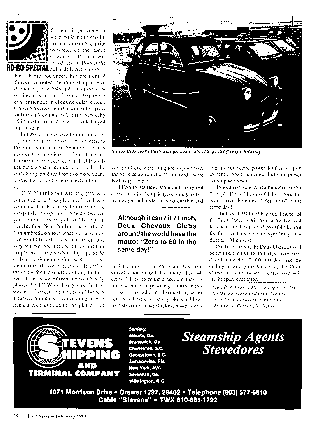. By Debra Nelson
The ugliest little car rolled off a ship in
December, destined to be owned by one of the world's most beautiful women. The woman falls
in love with the car. The car is still so ugly it's cute, and everybody lives happily ever
after. An updated Hans Christian Anderson tale? No, just another cargo move at the Port of
Charleston.
The car, a restored 1967 Citrben Deux Chevaux (2CV), a
burgundy and black "Charleston model," travelled from France to Charleston
aboard the Wallenius Lines' Faust. it was a surprise Christmas present for Christie
Brinkley from her husband, musician Billy Joel.
David Allen, a Buford, Georgia-based Citroen enthusiast, was the matchmaker in the deal.
Allen, the only exclusive Citroen broker and locator, began his love affair with the
little car during the 1960s when there were very few in the United States. His interest
expanded to a full-time job. Today, he owns 12 Citroen, 9 of them 2CVs.
What is the ugly duckling's appeal? Billy Joel said in the Gainesville, Georgia Times,
"I bought a Deux Chevaux for Christie, who lived in Paris for a number of years. I
knew she still had a great fondness for things French and the Deux Chevaux screams France.
As for me, I think the car is homely, and yet somehow appealing."
The Deux Chevaux is a no-frills, basic vehicle that everybody loves. Standard equipment is
an air-cooled two-cylinder engine, four-doors, front wheel drive and a convertible top.
"It is the only car that has more doors than cylinders," said Allen.
The Deux Chevaux has always been popular, but has recently become a collector's car
significantly because Citroen discontinued production in June 1990, ending a 42 year
production period during which "very few changes were made," Allen said.
The car was designed before World War II. On the drawing board, Citroen called the car the
"TPV" ("toute petite voiture" or "tiny little car."). With
war imminent in Europe, Citroen destroyed 249 prototype cars to keep them away from
Germany. Only one car, a sample representing all the latest pre-war developments, was
hidden safely on a farm and brought out after the war ended. Development continued and further improvements were made in this revolutionary automobile prior to its
release as the " Deux Chevaux" The car was introduced in 1948 at
the Salon de L'Automobile in Paris. Pierre Boulanger, then president of Citroen, unveiled
the show-stopper. Production began in 1949 and continued without interruption for 42
years. Despite the constant tongue-in-cheek ridicule the Deux Chevaux received from the
automotive press and the snide comments from the public, by 1950 production orders were
backlogged for six years.
In 1988 Citroen moved its manufacturing facility from the outskirts of' Paris to Portugal.
Shortly after the move, the firm decided to discontinue the Deux Chevaux because it wasn't
deemed a profitable product, but a world-wide outcry resulted in the car's being produced
for two more years. Today the car has become a real collector's item.
THE PEOPLE'S CAR. The 2CV was conceived as
a "peoples' car," and was economical to buy, easy to maintain and inexpensive to
operate (some models can get up to 55 miles per gallon). The original mandate from Pierre
Boulanger was to build, "an umbrella on four wheels . . a vehicle that would be
extremely economical and very reliable, one that could transport four people and 110
pounds of luggage at 35 mph in maximum comfort, with a ride so smooth that a basket Of
eggs Could travel on the seat without a single egg being broken, even if the car were
driven across a freshly plowed field." Wow. Every specification was met.The seating
provided in 1948 was a canvas Hammock literally hung from a frame at roof level, and
although the final cars produced were not quite so primitive, the basic design and the
"improved" were both very simple.
LESS IS MORE. Allen said the appeal of the
car is its "simplicity, economy, eclectic design and style. It is so durable and
quaint compared to others and has been virtually unchanged for more than 40
years." It is so reliable because there is nothing much to go wrong. Consider this
car with no radiator, thermostats, water pumps or hoses; no head gaskets to blow, no
distributor, power brakes, power steering, power seats, power lumbar support systems,
power antenna, locks or power windup windows.
Does it go? Sure. And although it can hit 71 mph, Deux Chevaux Clubs around the world have
the motto: "Zero to 60 in the same day!"
"In July, 1991 the 9th annual Friends of the Deux Chevaux will meet in Switzerland to
talk about the cars and probably lament the fact that they are no longer being
produced," Allen said.
Produced or not, the Deux Chevaux will be around for awhile. In fact, Citroen produced
more than 7,000,000. Just like the ending in any good fairy tale, the Deux Chevaux and its
owner, like true love, will last happily ever after.
Lura B. Williams CHB was import broker for the move. She
said in the last year some 19 2CVs have been imported through the Port of Charleston. |




